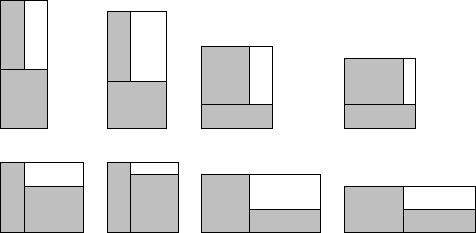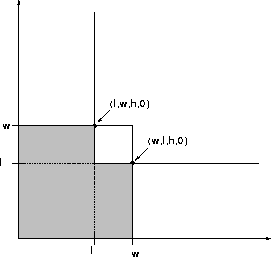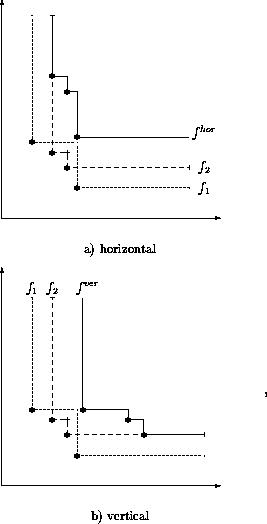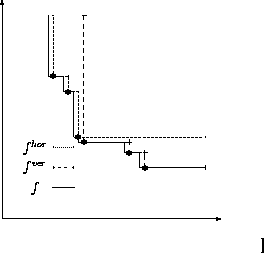Shape Functions
Next: Slicing Trees
Up: Cutting Stock by Iterated
Previous: The Two Dimensional
A meta rectangle has several layouts according to the orientation of
the horizontal or vertical cut which is used to split the meta rectangle
into the two buddies it resulted from. The layout also depends on the
alignments of the demand rectangles the meta rectangle contains.
The alignments of the demand rectangles are not fixed at any time the
algorithm proceeds. For example, if we match two demand rectangles  and
and  the resulting meta rectangle
the resulting meta rectangle  has eight essentially different layouts:
has eight essentially different layouts:  lies above or left from
lies above or left from  and both rectangles can be rotated.
Figure 2 shows the eight essentially different layouts
for a meta rectangle consisting of two demand rectangles.
and both rectangles can be rotated.
Figure 2 shows the eight essentially different layouts
for a meta rectangle consisting of two demand rectangles.

Figure 2:
Layouts for a meta rectangle with two demand rectangles
A single layout of a meta rectangle is represented by a slicing instruction.
This is a four dimensional vector ( ), where
), where  and
and  are the
length and width of the meta rectangle in its considered layout,
are the
length and width of the meta rectangle in its considered layout,
 is the orientation of the horizontal or vertical cut used to
split it and
is the orientation of the horizontal or vertical cut used to
split it and  is the point (according to
is the point (according to  ) where the cut starts.
) where the cut starts.
To describe all possible layouts of a meta rectangle, a shape function is used.
Such functions are known from floorplanning problems [Sto 1983],
[Ott 1983].
A shape function  for a rectangle
for a rectangle  can be considered as a
decreasing, piecewise linear function. The interpretation
is that
can be considered as a
decreasing, piecewise linear function. The interpretation
is that  is an upper bound on the length of a (meta) rectangle that has
the width
is an upper bound on the length of a (meta) rectangle that has
the width  .
So, if a meta rectangle has been computed which contains a set of
demand rectangles and if the dimensions of the stock rectangle are known,
the maximal needed
.
So, if a meta rectangle has been computed which contains a set of
demand rectangles and if the dimensions of the stock rectangle are known,
the maximal needed  -dimension for a layout of the meta rectangle
can be found subject to the given width of the stock rectangle.
-dimension for a layout of the meta rectangle
can be found subject to the given width of the stock rectangle.

Figure:
Shape function of a demand rectangle
A shape function is considered as a list of slicing instructions.
The shape function of a demand rectangle of length  and width
and width  consists of two slicing instructions
consists of two slicing instructions  .
The cut orientation and its starting point is of no use here, but later
we will need this information for the cutting of meta rectangles
unequal to demand rectangles. In Figure
.
The cut orientation and its starting point is of no use here, but later
we will need this information for the cutting of meta rectangles
unequal to demand rectangles. In Figure  an example of
a shape function for a demand rectangle is given.
an example of
a shape function for a demand rectangle is given.
The shape function of a meta rectangle is calculated by the shape functions
of the two demand or meta rectangles it consists of, with the help of the
composition procedure:
Let  and
and  be two shape functions and
be two shape functions and
 a slicing instruction of
a slicing instruction of  (
( ). The composed slicing instruction for a horizontal resp. vertical
cut is:
). The composed slicing instruction for a horizontal resp. vertical
cut is:
- horizontal cut:

- vertical cut:

By composing all slicing instructions of  with those of
with those of  ,
two shape functions
,
two shape functions  and
and  are computed which contain all
possible horizontal resp. vertical slicing instructions.
Figure 3 shows a horizontal and vertical shape function,
resulting from the composition of the shape functions of two
demand rectangles.
Three slicing instructions per cut orientation are found.
This leads to the fact that a layout of the resulting
meta rectangle is not included in the list of slicing instructions, if
another layout of the same width but a smaller length or the same length but
a smaller width exists. Hence, only feasible slicing instructions are
stored in the shape function. For example, layout three and
four in the upper row and layouts one and two in the lower row
of Figure 2 are treated in this way.
are computed which contain all
possible horizontal resp. vertical slicing instructions.
Figure 3 shows a horizontal and vertical shape function,
resulting from the composition of the shape functions of two
demand rectangles.
Three slicing instructions per cut orientation are found.
This leads to the fact that a layout of the resulting
meta rectangle is not included in the list of slicing instructions, if
another layout of the same width but a smaller length or the same length but
a smaller width exists. Hence, only feasible slicing instructions are
stored in the shape function. For example, layout three and
four in the upper row and layouts one and two in the lower row
of Figure 2 are treated in this way.

Figure 3: Shape functions with given cut orientation

Figure 4: Minimum shape function
To calculate a single shape function  for a meta rectangle, we
take the minimum about
for a meta rectangle, we
take the minimum about  and
and  by merging this two functions
and deleting the dominated slicing instructions. For example, a
slicing instruction of
by merging this two functions
and deleting the dominated slicing instructions. For example, a
slicing instruction of  is dominated by one of
is dominated by one of  , if
, if
 for a given width
for a given width  . If two slicing instructions
of
. If two slicing instructions
of  and
and  have the same width and the same length then
we will determine here, that the horizontal cut is chosen.
have the same width and the same length then
we will determine here, that the horizontal cut is chosen.
The maximal number of slicing instructions that have to be stored in a
shape function  which is calculated by composing two other shape
functions
which is calculated by composing two other shape
functions  and
and  is
is  , where
, where  denotes
the number of slicing instructions in function
denotes
the number of slicing instructions in function  (see [Mue 1991]).
(see [Mue 1991]).
Figure 4 shows the minimum shape function of the functions
 and
and  shown in Figure 3.
In this example of calculating the minimum function, no dominated
slicing instructions have to be deleted.
shown in Figure 3.
In this example of calculating the minimum function, no dominated
slicing instructions have to be deleted.
Next: Slicing Trees
Up: Cutting Stock by Iterated
Previous: The Two Dimensional
Andreas Fritsch
Mon Dec 19 14:08:31 MET 1994
 and
and  the resulting meta rectangle
the resulting meta rectangle  has eight essentially different layouts:
has eight essentially different layouts:  lies above or left from
lies above or left from  and both rectangles can be rotated.
Figure 2 shows the eight essentially different layouts
for a meta rectangle consisting of two demand rectangles.
and both rectangles can be rotated.
Figure 2 shows the eight essentially different layouts
for a meta rectangle consisting of two demand rectangles.

 ), where
), where  and
and  are the
length and width of the meta rectangle in its considered layout,
are the
length and width of the meta rectangle in its considered layout,
 is the orientation of the horizontal or vertical cut used to
split it and
is the orientation of the horizontal or vertical cut used to
split it and  is the point (according to
is the point (according to  ) where the cut starts.
) where the cut starts.
 for a rectangle
for a rectangle  can be considered as a
decreasing, piecewise linear function. The interpretation
is that
can be considered as a
decreasing, piecewise linear function. The interpretation
is that  is an upper bound on the length of a (meta) rectangle that has
the width
is an upper bound on the length of a (meta) rectangle that has
the width  .
So, if a meta rectangle has been computed which contains a set of
demand rectangles and if the dimensions of the stock rectangle are known,
the maximal needed
.
So, if a meta rectangle has been computed which contains a set of
demand rectangles and if the dimensions of the stock rectangle are known,
the maximal needed 
 and width
and width  consists of two slicing instructions
consists of two slicing instructions  .
The cut orientation and its starting point is of no use here, but later
we will need this information for the cutting of meta rectangles
unequal to demand rectangles. In Figure
.
The cut orientation and its starting point is of no use here, but later
we will need this information for the cutting of meta rectangles
unequal to demand rectangles. In Figure  and
and  be two shape functions and
be two shape functions and
 a slicing instruction of
a slicing instruction of  (
( ). The composed slicing instruction for a horizontal resp. vertical
cut is:
). The composed slicing instruction for a horizontal resp. vertical
cut is:


 and
and  are computed which contain all
possible horizontal resp. vertical slicing instructions.
Figure
are computed which contain all
possible horizontal resp. vertical slicing instructions.
Figure 

 for a meta rectangle, we
take the minimum about
for a meta rectangle, we
take the minimum about  for a given width
for a given width  , where
, where  denotes
the number of slicing instructions in function
denotes
the number of slicing instructions in function